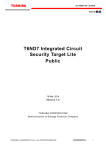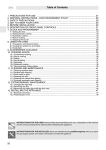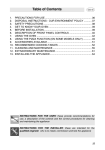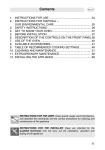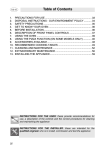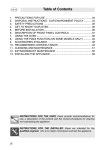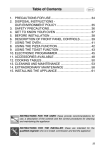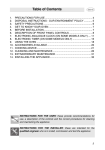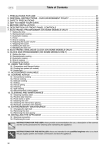Download Smeg SCP108SG Microwave Oven User Manual
Transcript
Table of Contents 1. 2. 3. 4. 5. 6. 7. 8. 9. 10. 11. 12. PRECAUTIONS FOR USE ......................................................... 32 DISPOSAL INSTRUCTIONS - OUR ENVIRONMENT POLICY33 SAFETY PRECAUTIONS ........................................................... 34 GET TO KNOW YOUR OVEN.................................................... 35 BEFORE INSTALLATION........................................................... 35 DESCRIPTION OF FRONT PANEL CONTROLS ......................36 USING THE OVEN ..................................................................... 38 ACCESSORIES AVAILABLE...................................................... 45 RECOMMENDED COOKING TABLES ...................................... 46 CLEANING AND MAINTENANCE.............................................. 49 EXTRAORDINARY MAINTENANCE.......................................... 54 INSTALLING THE APPLIANCE.................................................. 57 INSTRUCTIONS FOR THE USER: these provide recommendations for use, a description of the controls and the correct procedures for cleaning and maintaining the appliance INSTRUCTIONS FOR THE INSTALLER: these are intended for the qualified engineer who is to install, commission and test the appliance 31 Precautions for Use 1. PRECAUTIONS FOR USE THIS MANUAL IS AN INTEGRAL PART OF THE APPLIANCE. TAKE GOOD CARE OF IT AND KEEP IT TO HAND THROUGHOUT THE OVEN'S LIFE CYCLE. WE URGE YOU TO READ THIS MANUAL AND ALL THE INFORMATION IT CONTAINS CAREFULLY BEFORE USING THE APPLIANCE. INSTALLATION MUST BE CARRIED OUT BY QUALIFIED STAFF IN COMPLIANCE WITH THE RELEVANT REGULATIONS. THIS APPLIANCE IS INTENDED FOR HOUSEHOLD USE AND COMPLIES WITH THE EEC DIRECTIVES CURRENTLY IN FORCE. THE APPLIANCE IS BUILT TO PROVIDE THE FOLLOWING FUNCTION: COOKING AND HEATING FOODS; ALL OTHER USES ARE TO BE CONSIDERED IMPROPER. THE MANUFACTURER DECLINES ALL LIABILITY FOR USES OTHER THAN THOSE STATED ABOVE. NEVER USE THIS APPLIANCE FOR HEATING ROOMS. NEVER LEAVE PACKAGING RESIDUES UNATTENDED IN THE HOME. SEPARATE THE VARIOUS PACKAGING MATERIALS BY TYPE AND CONSIGN THEM TO THE NEAREST SEPARATE DISPOSAL CENTRE. THIS APPLIANCE IS TAGGED UNDER EUROPEAN DIRECTIVE 2002/96/EC ON WASTE ELECTRICAL AND ELECTRONIC EQUIPMENT (WEEE). THIS DIRECTIVE CONTAINS THE REGULATIONS GOVERNING THE COLLECTION AND RECYCLING OF DECOMMISSIONED APPLIANCES THROUGHOUT THE EUROPEAN UNION. NEVER OBSTRUCT THE OPENINGS VENTILATION AND HEAT DISPERSAL. AND SLITS PROVIDED FOR THE NAMEPLATE WITH THE TECHNICAL DATA, SERIAL NUMBER AND MARK IS IN A VISIBLE POSITION ON THE OVEN DOOR FRAME. THE NAMEPLATE MUST NEVER BE REMOVED. NEVER USE METAL SCOURING PADS OR SHARP SCRAPERS; THEY WILL DAMAGE SURFACES. USE ORDINARY NON-ABRASIVE PRODUCTS WITH THE AID OF WOODEN OR PLASTIC UTENSILS IF NECESSARY. RINSE THOROUGHLY AND DRY WITH A SOFT CLOTH OR CHAMOIS LEATHER. DO NOT ALLOW SPILLS OF FOODS WITH HIGH SUGAR CONTENT (E.G. JAM) TO DRY INSIDE THE OVEN. IF THEY DRY FOR TOO LONG, THEY MIGHT DAMAGE THE ENAMEL COATING OF THE INSIDE OF THE OVEN. 32 Disposal instructions 2. DISPOSAL INSTRUCTIONS ENVIRONMENT POLICY - OUR Our products are only packaged using non-pollutant, environment-friendly, recyclable materials. We urge you to cooperate by disposing of the packaging properly. Contact your local dealer or the competent local organisations for the addresses of collection, recycling and disposal facilities. Never leave all or part of the packaging lying around. Packaging parts, and especially plastic bags, may represent a suffocation hazard for children. Your old appliance must also be disposed of properly. Important: deliver the appliance to your local organisation authorised to collect scrapped appliances. Proper disposal allows the intelligent recovery of valuable materials. Before scrapping your appliance it is important to remove doors and leave shelves in position as for use, to ensure that children cannot accidentally become trapped inside the oven during play. Also, cut the power supply lead and remove it and the plug. 33 Safety precautions 3. SAFETY PRECAUTIONS REFER TO THE INSTALLATION INSTRUCTIONS FOR THE SAFETY REGULATIONS FOR ELECTRIC OR GAS APPLIANCES AND VENTILATION FUNCTIONS. IN YOUR INTEREST AND TO ENSURE YOUR SAFETY, BY LAW ALL ELECTRIC APPLIANCES MUST ONLY BE INSTALLED AND SERVICED BY QUALIFIED STAFF, IN ACCORDANCE WITH THE RELEVANT REGULATIONS. OUR APPROVED INSTALLATION ENGINEERS GUARANTEE YOU A JOB WELL DONE. GAS OR ELECTRIC APPLIANCES MUST ALWAYS BE DISCONNECTED BY SUITABLY SKILLED PEOPLE. THE PLUG TO BE CONNECTED TO THE POWER SUPPLY LEAD AND THE RELATIVE SOCKET MUST BE OF THE SAME TYPE AND COMPLY WITH THE RELEVANT REGULATIONS. THE POWER SUPPLY SOCKET MUST BE ACCESSIBLE EVEN AFTER THE APPLIANCE HAS BEEN BUILT-IN. NEVER DISCONNECT THE PLUG BY PULLING ON THE POWER SUPPLY LEAD. THE APPLIANCE MUST BE CONNECTED TO EARTH IN COMPLIANCE WITH ELECTRICAL SYSTEM SAFETY REGULATIONS. IMMEDIATELY AFTER INSTALLATION, CARRY OUT A QUICK TEST ON THE APPLIANCE FOLLOWING THE INSTRUCTIONS PROVIDED LATER IN THIS MANUAL. IF THE APPLIANCE FAILS TO OPERATE, DISCONNECT IT FROM THE ELECTRICAL MAINS AND CONTACT YOUR NEAREST SERVICE CENTRE. NEVER ATTEMPT TO REPAIR THE APPLIANCE. NEVER PLACE INFLAMMABLE OBJECTS IN THE OVEN: IF IT SHOULD ACCIDENTALLY BE SWITCHED ON, THIS MIGHT CAUSE A FIRE. THE APPLIANCE BECOMES VERY HOT DURING USE. TAKE CARE NOT TO TOUCH THE HEATING ELEMENTS INSIDE THE OVEN. THE APPLIANCE IS INTENDED FOR USE BY ADULTS. KEEP CHILDREN AT A SAFE DISTANCE AND NEVER ALLOW THEM TO PLAY WITH IT. WHEN THE GRILL IS IN OPERATION, ACCESSIBLE PARTS MAY BECOME VERY HOT: KEEP CHILDREN AT A SAFE DISTANCE. AFTER EACH USE, ALWAYS CHECK THAT THE CONTROL KNOBS ARE TURNED TO 0 (OFF). BEFORE THE APPLIANCE IS PUT INTO OPERATION, ALL THE PROTECTIVE FILMS APPLIED ON THE OUTSIDE MUST BE REMOVED. The manufacturer declines all responsibility for injury or damage caused by failure to comply with the above regulations or deriving from tampering with even just one part of the appliance and the use of non-original spare parts. 34 Instructions for the User 4. GET TO KNOW YOUR OVEN CONTROL PANEL OVEN LIGHT OVEN FAN SHELF AND TRAY RUNNERS TEMPERATURE SENSOR 5. BEFORE INSTALLATION Never leave packaging residues unattended in the home. Separate waste packaging materials by type and consign them to the nearest separate disposal centre. The inside of the appliance should be cleaned to remove all manufacturing residues. For further information about cleaning, see point "10. CLEANING AND MAINTENANCE". When the oven and grill are used for the first time, they should be heated to the maximum temperature for long enough to burn off any oily residues left by the manufacturing process, which might contaminate foods with unpleasant smells. After an interruption in the electricity supply, the programmer display flashes at regular intervals. For setting instructions, see point "7.3 First use". 35 Instructions for the User 6. DESCRIPTION OF FRONT PANEL CONTROLS All the appliance's control and monitoring devices are placed together on the front panel. The table below provides the key to the symbols used. THERMOSTAT-TIMER KNOB PT1 This knob allows you to set the time, select the cooking temperature and duration and program the cooking start and end times. From now on, for convenience it will be referred to as PT1. For instructions on how to use it correctly, see point “7.3 First use” and “7.5 Programmed cooking procedures”. DISPLAY DSP1 With the oven off, the 4-figure LED display shows the current time; when the oven is in operation, it shows the temperature set and the cooking duration set. The display also contains the function cutout light Secondary menu”), the timer pilot light programmed cooking operations , (see point “7.6 , the symbols relating to the and the door locked symbol From now on, for convenience it will be referred to as DSP1. 36 . Instructions for the User FUNCTION-SWITCH ON KNOB PT2 Simply turn this knob to the right or left to select the function required, from those listed below. From now on, for convenience it will be referred to as PT2. The table below provides a short description of the functions available: NO FUNCTION SET GRILL ELEMENT + FAN GRILL ELEMENT IN OPERATION ALTERNATING WITH BOTTOM HEATING ELEMENT + FAN BOTTOM HEATING ELEMENT + FAN TOP + BOTTOM HEATING ELEMENTS ECO AUTOMATIC CLEANING CYCLE (ENERGY SAVING PYROLYSIS) GRILL ELEMENT AUTOMATIC CLEANING CYCLE (PYROLYSIS) TOP + BOTTOM HEATING ELEMENTS+FAN 37 Instructions for the User 7. USING THE OVEN 7.1 Precautions and General Advice All cooking operations must be carried out with the door closed When the oven and grill are used for the first time, they should be heated to the maximum temperature for long enough to burn off any oily residues left by the manufacturing process, which might contaminate foods with unpleasant smells. During cooking, do not cover the bottom of the oven with aluminium or tin foil, and do not place pans or trays on it; this may damage the enamel coating. If you wish to use greaseproof paper, position it so that it does not interfere with the hot air circulation inside the oven. Oven accessories which may come into contact with foods are made from materials compliant with directive 89/109/EEC of 21/12/88 and relevant national regulations. To avoid unpleasant contact with any steam inside the oven, open the door in two stages: hold it halfopen (about 5 cm) for 4-5 seconds, then open it completely. If you have to carry out any procedures on foods, leave the door open for as short a time as possible to prevent a drop in the oven temperature which will impair the cooking results. To prevent excessive amounts of condensation from forming on the internal glass, food should not be left inside the oven for too long after cooking. 7.2 Operating modes This appliance is programmed to provide 3 operating settings: OFF setting: obtained with knob PT2 turned to the “0” symbol and current time shown on the display. ON setting: obtained with selector knob PT2 turned to any function and temperature set or PYro, if in pyrolysis, shown on the display. Standby setting: obtained with selector knob PT2 turned to any function and a timed cooking operation set and current time shown on the display. 38 Instructions for the User 7.3 First use At first use, or after a power failure, the oven display (DSP1), will show a flashing symbol. To start any cooking operation, the current time must be set. (For further information about setting or adjusting the current time, see point "7.6 Secondary menu"). 7.4 Selecting the function To select a cooking function, turn PT2. Then select the temperature required. 7.4.1 Cooking with preset temperature After selection of the function required, the oven will start the cooking procedure at the preset temperature. Cooking itself is preceded by a preheating stage (common to all functions) which allows the oven to heat to the cooking temperature more quickly. The symbol flashes on the display (DSP1) to indicate that this stage is in progress. When the preheating stage is over, the symbol will remain constantly on to indicate that the food can be placed inside the oven. 7.4.2 Changing the preset temperature The temperature preset for each function can be changed to suit the user's requirements. At any time while cooking is in progress, turn PT1 in either direction to increase or decrease the cooking temperature by 5 degrees at a time. PT1 can also be held in the left or right position to increase or decrease the setting more quickly. 7.5 Programmed cooking procedures 7.5.1 Timed cooking with minute minder From ON status (see point “7.2 Operating modes”), press PT1 once. The display will show the figures (constantly on) and the symbol (flashing). Turn PT1 to set the minutes of cooking (from 00:01 to 23:59). A few seconds later, the symbol will stop flashing, and the countdown will start from that moment. Now you can also select the cooking function required and wait for the buzzer to sound, indicating that the cooking time is over. Press PT1 once to stop the buzzer. You can now set an additional cooking time by turning PT1, or return to display of the current time by pressing PT1 twice. Turn PT2 to the "0" symbol to switch the oven off completely. The minute minder also works with no function set. 39 Instructions for the User Warning: the minute minder does not stop the cooking process. It only warns the user that the preset number of minutes have passed. To switch the oven off completely, turn PT2 to the "0" symbol. Modifying the data set Once the countdown has started, its duration can be changed while cooking is in progress. When the symbol is steady, press PT1 once. The symbol starts flashing and PT1 can be turned to change the set duration. A few seconds after the last change, the symbol will stop flashing, and the countdown will restart from the new value. To change the preset temperature, wait for the symbol to become steady and turn PT1 to the right or left to increase or decrease the cooking temperature. 7.5.2 Semiautomatic cooking Semiautomatic cooking is the function which allows a cooking operation to be started and then ended after a specific length of time set by the user. Select a cooking function (see point “7.4 Selecting the function”) and press PT1 twice. The display will show the figures and the symbol (flashing). Turn PT1 to the right or left to set the minutes of cooking (from 00:01 to 23:59). A few seconds after the required duration is set, the symbol will stop flashing, and semiautomatic cooking will start from that moment. At the end, the word STOP will appear on DSP1, cooking will stop and a buzzer will sound; press PT1 once to deactivate it. If you wish to continue cooking beyond the set time, press PT1 again. The oven will restart normal operation with the cooking settings selected previously. Turn PT2 to the "0" symbol to switch the oven off completely. Modifying the data set Once semiautomatic cooking has started, its duration can be changed. When the symbol is steady, press PT1 once. The symbol starts flashing and PT1 can be turned to change the set duration. A few seconds after the last change, the symbol will stop flashing, and semiautomatic cooking will restart from the new value. To change the preset temperature, wait for the symbol to become steady and turn PT1 to the right or left to increase or decrease the cooking temperature. 40 Instructions for the User 7.5.3 Automatic cooking Automatic cooking is the function which allows a cooking operation to be started at a set time and then ended after a specific length of time set by the user. Select a cooking function, set the cooking temperature required or leave the preset temperature (see point “7.4 Selecting the function”) and press PT1 twice. The display will show the figures and the symbol (flashing). Turn PT1 to the right or left to set the minutes of cooking (from 00:01 to 23:59). For reasons of safety, when setting automatic cooking the user must first program a cooking duration and then set the cooking start time. It is not possible to set the cooking start time only, without setting the cooking duration. After setting the duration, press PT1 once. The symbol and the current time will appear on the display. Turning PT1 to the right increases the time, allowing the cooking start time required to be set. A few seconds after the required duration is set, the and symbols will stop flashing and will become solid, and the oven will start to wait for the starting time set. At the end, the word STOP will appear on DSP1, cooking will stop and a buzzer will sound; press PT1 once to deactivate it. If you wish to continue cooking beyond the set time, press PT1 again. The oven will restart normal operation with the cooking settings selected previously. Turn PT2 to 0 to switch off the oven. Modifying the data set Once automatic cooking has started, its duration can be changed. When the and symbols are steady and cooking is in progress, or the oven is in standby status waiting for cooking to start, press PT1 once. The symbol starts flashing and PT1 can be turned to change the set duration. Press PT1 again; the symbol goes out, the symbol will start to flash, and the cooking start time will be displayed on DSP1. The cooking start time can be increased or decreased by turning PT1. A few seconds after the last change, the e symbols will appear (in steady mode) on DSP1 and automatic cooking will restart with the new settings. 41 Instructions for the User 7.6 Secondary menu This appliance also has a "secondary menu" allowing the user to: 1 Set the time shown on the display (DSP1). 2 (P1: OF / ON) Activate or deactivate the child safety lock ( ); this function locks out all the functions and knobs after 2 minutes of operation without any command from the user (when this system is active, the symbol appears on DPS1). To exit the lockout status temporarily to modify a cooking program or select a different function, keep PT1 pressed until the symbol disappears from DSP1. The required changes can now be made, and 2 minutes after the last setting is made the lockout will come into operation again. To deactivate the lockout permanently, access the secondary menu and switch the function off as described in this section. 3 (P2: OF / ON) Activate or deactivate the Show Room function, which disables all the heating elements so that only the control panel works. To allow the oven to be used normally, P2:OFF must be set. 4 (P3: OF / ON) Activate or deactivate the function which limits the maximum power absorption to 2300 W. When the child safety lock is activated (P1:ON), if a knob is turned “bLOC” appears on DSP1 for 2 seconds. Operating PT2 also triggers the “bLOC” alarm until the function originally selected is restored. 42 Instructions for the User 7.6.1 Modifying the secondary menu settings The secondary menu appears the first time the appliance is used or after a power blackout, or can be accessed by keeping PT1 depressed for 3 seconds with the oven in OFF status (see point “7.2 Operating modes”). Changing the settings of the secondary menu parameters is very easy. Refer to the chart below: MENU MODIFICATION PROCEDURE SYMBOLS Turn PT1 to the right to increase + ( ) the value or set ON status. Turn PT1 to the left to decrease - ( ) the value or set Off status. Press PT1 to move on to setting next of the parameter in the menu. After setting P3, pressing PT1 returns to normal oven operation. 43 Instructions for the User 7.7 Cooling fan system The appliance is equipped with a cooling system which comes into operation as soon as a cooking function or a cleaning cycle (Pyrolysis) starts. Operation of the fans generates a normal air flow which comes out above and underneath the door and may continue for a short time even after the oven is switched off. 7.8 Inside light The oven light comes on: • when the oven door is opened in OFF status (point “7.2 Operating modes”) or • 44 when the function knob is turned to any function, except and . Instructions for the User 8. ACCESSORIES AVAILABLE The oven is fitted with 4 runners for placing trays and shelves at different heights. Shelf: useful to support pans containing the food for cooking. Tray grid: for placing on top of a tray for cooking foods which may drip. Oven tray: useful for collecting fat from foods placed on the grid above. Baking tray: useful for cooking cakes, pizza and confectionery. Rotisserie frame (on some models only): supports the rotisserie rod (see page 48 for instructions for use). Rotisserie rod: useful for cooking chicken and all foods which require uniform cooking over their entire surface (see page 48 for instructions for use). Optional accessories Original accessories can be ordered through our Authorised Service Centres. 45 Instructions for the User 9. RECOMMENDED COOKING TABLES The oven must be preheated before all cooking operations. Do not place the foods inside the oven until the degrees Centigrade symbol on the display stops flashing and the beep has sounded to confirm that the set temperature has been reached. Cooking times, for meat in particular, vary depending on the food's thickness and quality and personal preference. All times are calculated with the oven preheated. CONVENTIONAL COOKING RUNNER POSITION FROM THE BOTTOM TEMPERATURE °C. TIME IN MINUTES PASTA LASAGNE PASTA BAKES 1 1 220 - 230 220 - 230 50 - 60 40 MEAT ROAST VEAL LOIN OF PORK SHOULDER OF PORK RABBIT TURKEY BREAST ROAST NECK OF PORK 2 2 2 2 2 2 190 - 200 190 - 200 190 - 200 190 - 200 190 - 200 190 - 200 80 - 90 80 - 90 100 - 110 70 - 80 160 - 180 190 - 210 FISH 1-2 160 - 170 Depending on size PIZZA 1-2 250 20 - 25 BREAD 1-2 200 - 210 40 2 190 - 200 20 - 25 1-2 1-2 1-2 1-2 1-2 1-2 1-2 1-2 1-2 160 - 170 160 - 170 160 - 170 160 - 180 160 - 170 160 - 170 160 - 170 160 - 170 160 - 170 55 - 60 30 - 40 20 - 25 25 - 30 30 - 35 60 60 40 - 45 40 - 45 MUFFINS CONFECTIONERY SPONGE CAKE FRUIT TART PASTRY CROISSANTS JAM TARTS RICE CAKE ANGEL CAKE ECLAIR LIGHT SPONGE CAKE 46 Instructions for the User HOT AIR COOKING RUNNER POSITION FROM THE BOTTOM TEMPERATURE °C. TIME IN MINUTES PASTA LASAGNE PASTA BAKES 2 2 210 - 230 210 - 230 45 - 50 25 - 30 MEAT ROAST VEAL LOIN OF PORK SHOULDER OF PORK RABBIT TURKEY BREAST ROAST CHICKEN 2 2 2 2 2 2 180 - 190 180 - 190 180 - 190 180 - 190 180 - 190 180 - 190 70 - 80 70 - 80 90 - 100 70 - 80 110 - 120 60 - 70 FISH SALMON TROUT PIZZA BREAD MUFFINS CONFECTIONERY SPONGE CAKE LARGE JAM TART PASTRY CROISSANTS JAM TARTS ANGEL CAKE 2 150 - 160 35 - 40 1-2 250 15 - 20 1 190 - 200 25 - 30 1-2 180 - 190 15 - 20 2 2 2 2 2 2 160 160 170 160 - 170 160 160 50 - 60 25 - 30 20 - 25 20 - 25 20 - 25 60 PROVING - DEFROSTING TEMPERATURE °C DEFROSTING FOODS NATURAL YEAST DOUGHS 30 35 - 40 For successful proving, a container of water should be placed in the bottom of the oven. 47 Instructions for the User GRILLING PORK CUTLET PORK FILLET FILLET STEAK SLICED LIVER VEAL ESCALOPES HALF CHICKEN SAUSAGE MEATBALLS FISH FILLET TOASTED SANDWICHES RUNNER POSITION FROM THE BOTTOM 1ST SIDE TIME IN MINUTES 2ND SIDE 4 3 3 4 4 3 3 3 3 3 7-9 9 - 11 9 - 11 2-3 7-9 9 - 14 7-9 7-9 5-6 2-4 5-7 5-9 9 - 11 2-3 5-7 9 - 11 5-6 5-6 3-4 2-3 ROTISSERIE COOKING Prepare the rotisserie rod with the food, tightening the screws A of the prongs. Fit the frame B onto the second runners from the bottom. Remove the handle D and position the rotisserie rod so that the pulley E is still in the guides on the frame B. Push the frame B fully in until the tip of the rotisserie rod enters the hole C on the rear wall of the oven. Place a basin F on the bottom bottom shelf and pour a little water into it to prevent smoke from forming. 48 Instructions for the User 10. CLEANING AND MAINTENANCE Before carrying out any operations, disconnect the appliance from the electricity supply. Never use a jet of steam for cleaning the inside of the oven. 10.1 Cleaning stainless steel To keep stainless steel in good condition, it must be cleaned regularly, after each use of the oven, after allowing it to cool. 10.2 Routine daily cleaning When cleaning and caring for stainless steel surfaces, always use only specific products which do not contain abrasives or chlorine-based acids. Instructions for use: pour the product onto a damp cloth and wipe over the surface, then rinse thoroughly and dry with a soft cloth or chamois leather. 10.3 Food stains or spills Never use metal scouring pads or sharp scrapers; they will damage surfaces. Use ordinary non-abrasive products with the aid of wooden or plastic utensils if necessary. Rinse thoroughly and dry with a soft cloth or chamois leather. Do not allow spills of foods with high sugar content (e.g. jam) to dry inside the oven. If they dry for too long, they might damage the enamel coating of the inside of the oven. 49 Instructions for the User 10.4 Cleaning the oven To keep the oven in good condition, it must be cleaned regularly, after allowing it to cool down. Remove all removable parts. • • Clean the oven shelves with hot water and non-abrasive detergents, rinse and dry. For easier cleaning, the door can be removed (see point “11.2 Removing the door”) 10.5 Cleaning the door glazing The glass in the door should always be kept thoroughly clean. Use absorbent kitchen roll; remove stubborn dirt with a damp sponge and ordinary detergent. Do not use abrasive or corrosive cleaners for cleaning the door glazing (e.g. powder products, oven-cleaner sprays, stain removers and metal scouring pads). Do not use rough or abrasive materials or sharp metal scrapers to clean the oven's glass doors since they may scratch the surface and cause the glass to shatter. 50 Instructions for the User 10.6 Pyrolysis: automatic oven cleaning Pyrolysis is an automatic high-temperature cleaning procedure which causes dirt to dissolve. Before starting the automatic cleaning cycle, make sure that the oven does not contain any foods or large spills from previous cooking operations inside. During the pyrolysis cycle adoor interlock device makes it impossible to open the door. IF THE OVEN IS INSTALLED UNDERNEATH A HOB, MAKE SURE THAT THE BURNERS OR ELECTRIC PLATES REMAIN OFF DURING THE AUTOMATIC CLEANING CYCLE. 10.6.1 Before starting the automatic cleaning cycle Pyrolysis may be carried out at any time of the day or night (if you wish to benefit from the lower cost of electricity overnight). Before proceeding, check the following: • only the baking tray and the oven tray may be left inside the oven since they will withstand the high temperatures of the pyrolysis process; all the other accessories must be removed from inside the oven. • make sure that the oven door is firmly closed. When setting the cleaning cycle duration, refer to the chart below: CLEANING DURATION LIGHT DIRT MEDIUM DIRT HEAVY DIRT 90 MIN. 135 MIN. 180 MIN. During the first automatic cleaning cycle unpleasant smells may occur due to the normal evaporation of oily manufacturing substances. This is an absolutely normal phenomenon which disappears after the first cleaning cycle. During the automatic cleaning cycle the fans make more noise because they are running at higher speed. This is an absolutely normal function, intended to provide more effective heat dispersal. At the end of the pyrolysis process the fans continue to run automatically for long enough to prevent overheating of the sides of the cabinet and the front of the oven. 51 Instructions for the User 10.6.2 How the automatic cleaning cycle works The table below shows an example of operation of the automatic cleaning cycle. About 2 minutes after the cleaning cycle starts an interlock device which prevents opening of the door is tripped. At the end of the cleaning cycle the thermostat light goes out. The door interlock is only released later, when the temperature inside the oven drops back below 300°C. 52 ON - ON 300 °C OFF 500 °C OFF 300 °C Instructions for the User 10.6.3 Setting the cleaning cycle Use PT2 to select one of the two pyrolysis functions ( and ) with the oven in OFF status (see point 7.4, Function Selection). To start the cleaning (Pyrolysis) cycle, press knob PT1 once to set its duration ( ). Turn knob PT1 to the right or left to increase or decrease the cycle duration between a minimum of 1h 30m and a maximum of 3h 00m (except for the function where the cycle duration is fixed at 1h 30m). The message PYro will appear on DSP1 to indicate that the oven is function, DSP1 shows Peco). performing the cleaning cycle (for the One minute after the cleaning (Pyrolysis) cycle starts an interlock device which prevents opening of the door will be tripped. The symbol illuminates on DSP1 to indicate that this interlock device has been activated. To select a cleaning cycle with delayed start, after setting the duration press PT1 once. The symbol and the current time will appear on the display. Turning PT1 to the right increases the time, allowing the cleaning start time required to be set. A few seconds after the required duration is set, the and symbols will stop flashing, and the oven will start to wait for the starting time set. It is not possible to select any functions once the door interlock has been activated. Wait for the symbol to go out. 53 Instructions for the User 11. EXTRAORDINARY MAINTENANCE Occasionally, the oven will require minor servicing procedures or the replacement of parts subject to wear and tear, such as gaskets, light bulbs, etc. The specific operations for each procedure of this kind are provided below. Before carrying out any operation involving access to live parts, disconnect the appliance from the electricity supply. 11.1 Changing the light bulb Remove the protective cover A by unscrewing it anti-clockwise and replace the bulb B with another of the same type (25 W). Replace the protective cover A. Use only light bulbs approved for ovens (T 500°C). 54 Instructions for the User 11.2 Removing the door 11.2.1 With type 1 mobile levers With the door completely open, lift the levers A of the two hinges until they touch the hinges B and take hold of the two sides of the door with both 1) hands close to the hinges. Raise the door to an angle of about 45° and remove it. If the hinges have not locked, repeat the operation, raising the levers A and keeping the door slightly raised. To reassemble, fit the hinges B into their grooves, then lower the door into place, ensuring that it remains fitted into the grooves C, then lower the levers A. 11.2.2 Removing doors with pins Open the door completely and insert the pins (supplied) into the holes from the inside. Close the door to an angle of about 45° and lift it off. To reassemble, fit the hinges into their grooves, then lower the door into place and extract the pins. 11.3 Removing the gasket To allow thorough cleaning of the oven, the door gasket can be removed. 55 Instructions for the User 11.4 Removing the inside glass with the door cold The glass in the door should always be kept thoroughly clean. For easier cleaning, the door glazing can be fully removed by proceeding as described below. After opening the door and locking it in place as described in point “11.2 Removing the door”, remove the three panes of glass. They are all removed in two stages: first extract the pane from the guide “A” (see detail) by sliding it towards you and lifting it slightly, then also free it from the guide "B". If the door should close during these operations, simply relock one of the hinges as described in point "11.2 Removing the door". The panes of glass can now be washed separately. Use absorbent kitchen roll; remove stubborn dirt with a damp sponge and ordinary detergent. Caution: before removing the panes of glass, make sure that at least one of the door's hinges has been locked in open position as described in points “11.2 Removing the door”. This operation might have to be repeated during the glass removal process if the door is accidentally freed. Caution: replace the panes of glass in the same order and in the same position as before removal, taking care to push the last pane with the marking into the guide A to lock it in place. When complete, release the hinges and close the door. 56 Instructions for the Installer 12. INSTALLING THE APPLIANCE 12.1 Electrical connection The nameplate with the technical data, serial number and mark is in a visible position on the oven door frame. The nameplate must never be removed. The appliance must be connected to earth in compliance with electrical system safety regulations. If a permanent connection is used, the appliance's power supply line must be fitted with an omnipolar breaking device with contact gap of at least 3 mm, located in an easily accessible position close to the appliance itself. If a socket and plug connection is used, check that they are of the same type. Do not use reducers, adapters or junctions since they may cause overheating or burns. Operation at 220-240 V~: use a type H05RR-F (3 x 1.5 mm2) or type H05V2V2-F (3 x 1.5 mm2) three-wire cable. The earth wire (yellow-green) must be at least 20 mm longer than the other wires at the end for connection to the appliance. If the power supply lead has to be replaced, remove the rear casing by undoing the screws as shown below. The power lead gauge must be at least 1.5 mm2 (3 X 1.5 cable) and it must withstand temperatures up to 90°C (H05V2V2-F). Make sure that the cables follow the best possible route and use band clamps to fix them at the side of the cabinet, to avoid any contact with the oven. 57 Instructions for the Installer 12.2 Positioning the oven The appliance is designed for building-in to cabinets made from any heatresistant material. Comply with the dimensions shown in figures 1, 2 and 3. When installing under worktops, comply with the dimensions shown in figure 1-3. When installing under worktops incorporating combined hobs, a gap of at least 110 mm must be left from any side wall, as shown in figure 1. When installing in tall units, comply with the dimensions shown in figure 12, bearing in mind that the top/rear of the unit must have an opening 80-90 mm deep. Screw the 2 screws A into the inside of the frame (fig. 1). For installation under counter-top hobs, make sure that the rear/bottom of the unit has an opening similar to that shown in figure 1 (ref. B). See the instructions supplied with the hob for the relative positioning and fixing procedures. Never use the door for leverage when inserting the oven in the cabinet. Never apply excessive pressure to the open door. 58




























